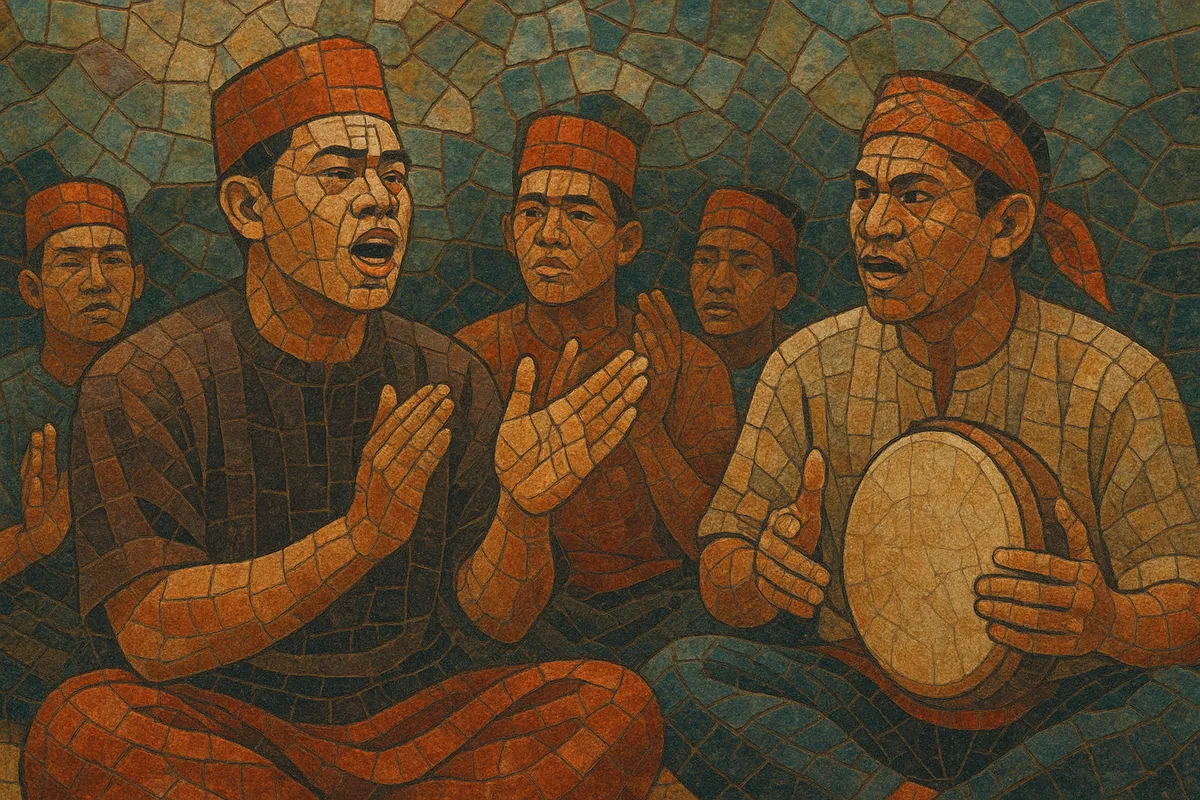
Dikir barat is a communal Malay choral performance tradition from the northeastern Malay Peninsula, especially Kelantan (Malaysia) and the Patani region (southern Thailand). It is typically performed by a seated ensemble that uses tightly synchronized clapping, body percussion, and antiphonal (call-and-response) singing.
A hallmark of the genre is its two complementary lead roles: the Tok Juara (primary song leader) and the Tukang Karut (improviser-satirist). The Tok Juara establishes the principal melody and mood, while the Tukang Karut steers a lively, often humorous section that delivers rapid-fire quatrains (pantun) commenting on social issues, morality, or everyday life. The chorus—called the awok-awok—anchors the texture with powerful unison refrains and rhythmic patterns.
While traditionally a cappella, dikir barat may include frame drums (rebana), small gongs, or a gendang for accentuation in modern settings. Today it thrives at cultural festivals and competitions, and has adapted to stage, broadcast, and online formats while maintaining its communal spirit and poetic wit.
Dikir barat took shape in the early 20th century in Kelantan (northeastern Malaysia) and the adjacent Patani region of southern Thailand. Its aesthetics reflect Malay communal singing and poetry (especially pantun), as well as broader Islamic choral-chant practices. Early ensembles performed largely without instruments, relying on coordinated clapping, stomping, and body percussion to drive momentum and frame the call-and-response between the lead and the chorus.
Two lead roles crystallized: the Tok Juara, who establishes melodies and guides the chorus, and the Tukang Karut, who improvises witty verses that respond to current events, local news, and moral themes. The Tukang Karut’s verses, typically in quatrain form, give the genre its distinctive blend of humor, satire, and social commentary. Performances served as entertainment, communal bonding, and gentle public discourse.
By the mid-to-late 20th century, dikir barat became a centerpiece of regional festivals, school and university activities, and inter-village contests. Competition formats favored clear sectional structures (a dignified opening led by the Tok Juara followed by faster, more playful Tukang Karut-led segments), disciplined chorus work, and sharp textual delivery. Broadcast media and cultural bodies helped standardize presentation while encouraging creative variation.
Contemporary troupes sometimes add frame drums or gendang for color, incorporate microphones and staging, and welcome mixed-gender participation. Online sharing has expanded the audience, and new texts address modern themes while honoring traditional pantun poetics. Despite these evolutions, dikir barat retains its core identity: a communal, rhythm-driven, text-centered art of wit, melody, and collective energy.
Structure the performance in two broad sections:
-
•
Opening led by the Tok Juara: establish the main melody, mood, and key refrain.
•Tukang Karut section: faster, playful delivery of improvised pantun with chorus responses.
Close with a strong unison refrain that reiterates the main theme.

